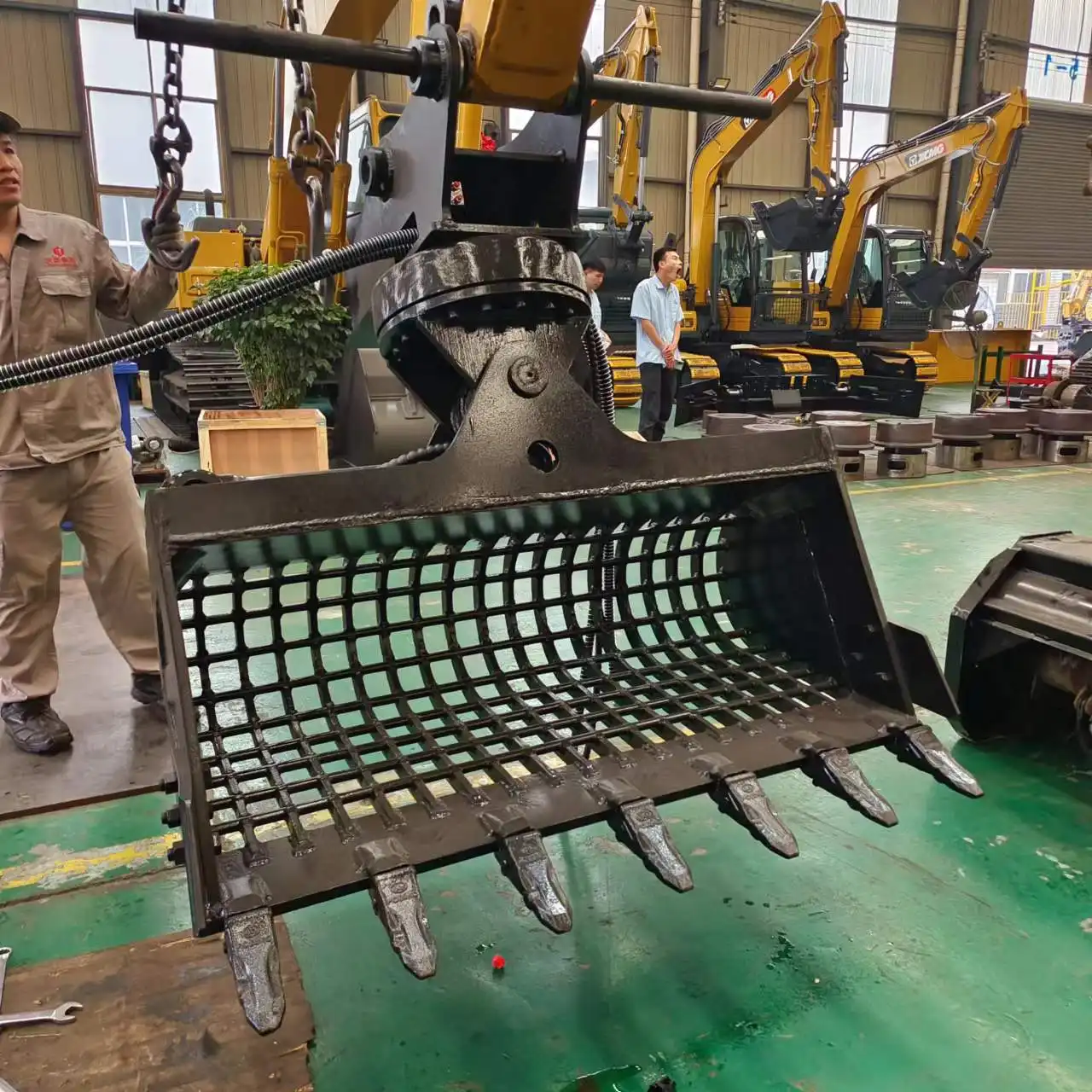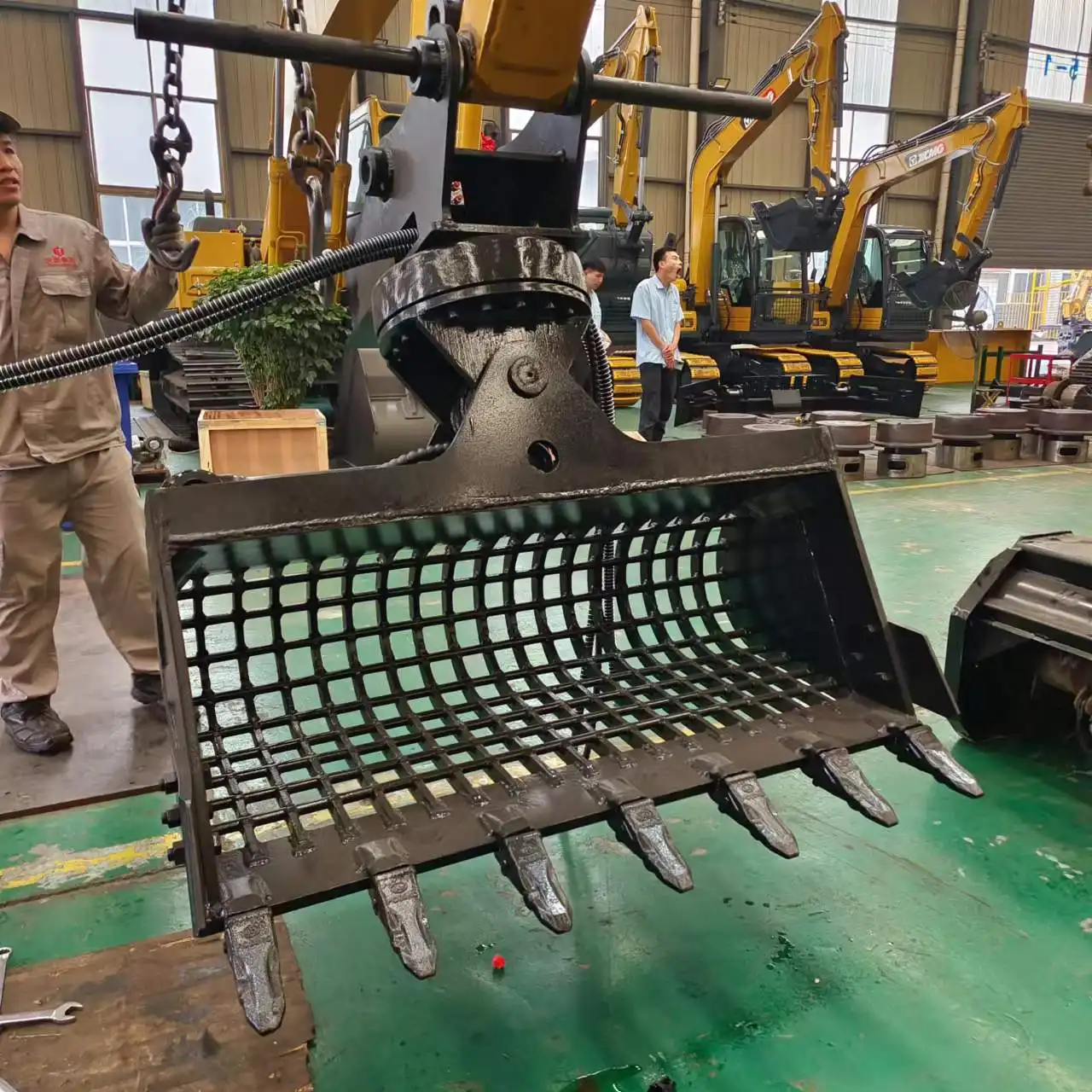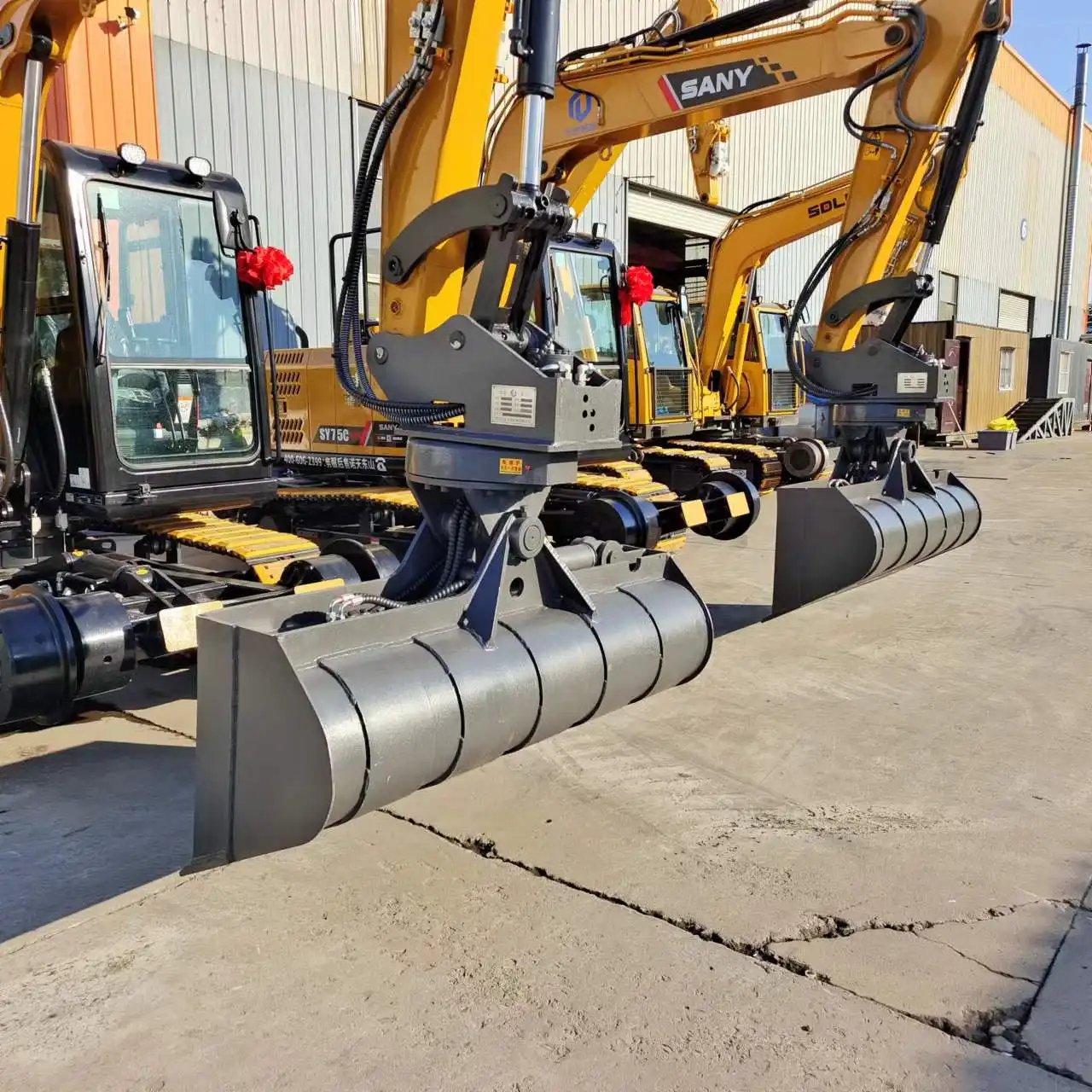Degree Rotating Hydraulic Tilt Ditching Bucket for Railway Maintenance
Railway maintenance demands precision, efficiency, and unwavering reliability. The degree rotating hydraulic tilt ditching bucket represents a revolutionary advancement in excavator attachments, specifically engineered to meet the rigorous demands of railway construction and maintenance operations. This sophisticated hydraulic attachment combines 360-degree rotation capabilities with 45-degree tilting functionality, delivering unmatched versatility for backfilling railway slag, shoulder forming operations, and precision ditching work. Unlike conventional fixed buckets that require constant repositioning of the excavator, this innovative attachment allows operators to achieve precise angles and reach challenging spots with minimal machine movement, dramatically reducing operational time while enhancing work quality. The advanced hydraulic control system ensures smooth, responsive operation, while the robust Q460 + WH60C material construction guarantees durability under the most demanding railway maintenance conditions.

Suitable for Backfilling Railway Slag
Backfilling railway slag requires exceptional precision and control to maintain proper track elevation and drainage characteristics. The hydraulic tilt bucket's multi-angle operation capability transforms this challenging task into a streamlined process that delivers consistent, professional results.
Enhanced Material Distribution Control
The 35-degree incline angle functionality provides operators with unprecedented control over material distribution patterns. When backfilling railway slag, maintaining proper compaction and grade is crucial for long-term track stability. The rotating mechanism allows operators to precisely position the bucket at optimal angles without repositioning the excavator, ensuring uniform material placement along the entire track section. This enhanced control minimizes material waste while maximizing operational efficiency, reducing project timelines and associated labor costs.
Professional railway contractors understand that material distribution consistency directly impacts track longevity and operational safety. The hydraulic tilt mechanism enables operators to adjust material flow rates and placement angles in real-time, responding to varying ground conditions and material characteristics. This adaptability proves essential when working with different slag compositions or when environmental conditions affect material handling properties. The precision control reduces material spillage and eliminates the need for manual reshaping, contributing to both cost savings and improved work quality standards.
The bucket's intelligent design incorporates wear-resistant materials that maintain performance characteristics even after extensive use in abrasive railway environments. The Q460 high-strength steel construction provides exceptional durability while the WH60C wear plates ensure extended service life in demanding applications. This material combination delivers superior performance compared to standard excavator attachments, reducing replacement frequencies and maintenance downtime that can disrupt critical railway maintenance schedules.
Precision Grade Management
Railway ballast and slag require specific gradation and compaction levels to ensure proper drainage and track stability. The degree rotating hydraulic tilt ditching bucket enables operators to achieve consistent grade profiles through its advanced tilting mechanism. The 0.4 cubic meter capacity strikes the perfect balance between productivity and maneuverability, allowing for controlled material placement without overwhelming the work area. This precision becomes particularly valuable when working around existing infrastructure where space constraints demand careful material handling.
Grade management extends beyond simple material placement to encompass comprehensive understanding of railway engineering principles. The attachment's multi-angle capabilities allow operators to create proper crown profiles that facilitate effective water drainage while maintaining structural integrity. The hydraulic system responds instantly to operator inputs, enabling micro-adjustments that ensure compliance with stringent railway engineering specifications. These capabilities prove invaluable when working on high-speed rail corridors where even minor grade variations can impact operational safety and passenger comfort.
Modern railway construction projects increasingly demand sustainable practices and material efficiency. The precision placement capabilities of this specialized attachment reduce material waste by ensuring accurate initial placement, eliminating the need for costly material removal and replacement cycles. This efficiency translates to reduced environmental impact and improved project economics, making it an attractive solution for contractors focused on sustainable construction practices and long-term client relationships.

Shoulder Forming Operation
Railway shoulder formation demands precise angles and consistent profiles to ensure proper drainage and structural integrity. The advanced tilting capabilities of this specialized attachment deliver superior results compared to conventional excavator buckets.
Precise Angle Achievement
Creating proper railway shoulders requires maintaining specific angles and slopes for effective water drainage and ballast retention. The 45-degree tilting range provides operators with the flexibility to achieve optimal shoulder profiles without constantly adjusting excavator position. This capability proves invaluable when working on curved track sections where shoulder angles must continuously vary to maintain proper drainage patterns. The hydraulic precision ensures consistent results across the entire project length, eliminating the variations that often occur with manual positioning methods.
Railway shoulder geometry follows strict engineering standards that govern slope angles, material composition, and structural integrity requirements. The attachment's precise angle control enables contractors to meet these exacting specifications while maintaining productive work rates. Professional operators appreciate the responsive hydraulic system that allows for fine adjustments during material placement, ensuring compliance with railway authority specifications and avoiding costly rework cycles that can delay project completion and impact profitability.
Environmental factors significantly influence shoulder forming operations, particularly during adverse weather conditions or when working with varying material moisture content. The degree rotating hydraulic tilt ditching bucket maintains consistent performance regardless of external conditions, enabling contractors to maintain project schedules even when conventional equipment struggles with precision requirements. This reliability translates to improved client satisfaction and enhanced reputation in the competitive railway construction marketplace.
Streamlined Workflow Integration
Modern railway construction projects demand efficient workflow integration to meet tight scheduling requirements. The degree rotating hydraulic tilt ditching bucket integrates seamlessly with existing excavator operations, eliminating the need for specialized equipment changes during shoulder forming activities. Operators can transition smoothly between different maintenance tasks without interrupting workflow or requiring additional equipment setup. This integration capability reduces overall project costs while maintaining high quality standards throughout the construction process.
Project management efficiency depends heavily on equipment versatility and operational continuity. The attachment's ability to handle multiple railway maintenance tasks eliminates equipment changeover delays that typically disrupt project schedules and increase labor costs. Construction supervisors can optimize crew assignments and equipment utilization, maximizing productive time while maintaining quality standards. This operational flexibility proves particularly valuable on large-scale railway infrastructure projects where schedule adherence directly impacts contract compliance and penalty avoidance.
Technology integration enhances modern construction project management through improved data collection and performance monitoring capabilities. The hydraulic system's responsive operation generates consistent performance data that enables project managers to optimize work schedules and resource allocation. This data-driven approach improves project profitability while ensuring quality standards that exceed client expectations and support long-term business relationships in the railway construction industry.

Ditching and Grading
Effective drainage management along railway corridors requires precision ditching and grading capabilities that maintain proper water flow while protecting track infrastructure. The rotating hydraulic tilt bucket delivers exceptional performance in these critical applications.
Advanced Drainage Channel Creation
Proper railway drainage channels require consistent depth, width, and slope characteristics to effectively manage water flow during various weather conditions. The bucket's 1600mm width and 550mm height dimensions provide optimal proportions for creating standard railway drainage ditches. The rotating capability allows operators to maintain consistent channel profiles even when working around curves or varying terrain conditions. This consistency proves crucial for long-term drainage effectiveness and reduces maintenance requirements over the infrastructure's operational lifetime.
Hydraulic engineering principles govern effective railway drainage design, requiring precise channel geometry to handle peak water flow conditions while preventing erosion damage. The attachment's advanced control system enables operators to create channels that meet or exceed engineering specifications for flow capacity and structural stability. Professional railway contractors recognize that proper initial drainage construction prevents costly maintenance issues and service disruptions that can impact railway operational reliability and customer satisfaction.
Environmental considerations increasingly influence railway drainage design, particularly regarding water quality management and ecosystem protection. The precision placement capabilities of the degree rotating hydraulic tilt ditching bucket enable contractors to create drainage systems that effectively manage runoff while minimizing environmental impact. This capability supports regulatory compliance and demonstrates environmental stewardship that enhances contractor reputation and supports sustainable business practices in the railway construction industry.
Climate change impacts create new challenges for railway drainage infrastructure, requiring robust systems capable of handling increased precipitation intensity and frequency. The attachment's versatility enables contractors to adapt drainage channel specifications to meet evolving climate requirements while maintaining construction efficiency. This adaptability proves valuable for railway infrastructure projects designed to withstand extreme weather events and maintain operational reliability under changing environmental conditions.
Precision Slope Management
Railway grading operations demand precise slope control to ensure proper water flow without creating erosion problems. The hydraulic tilting mechanism enables operators to achieve exact slope angles while maintaining smooth, consistent profiles. The degree rotating hydraulic tilt ditching bucket eliminates the irregular surfaces that often result from conventional grading methods, creating superior drainage performance. This precision becomes particularly important in areas prone to heavy precipitation where effective water management prevents track instability and service interruptions.
Slope stability analysis reveals that precise grading significantly impacts long-term infrastructure performance and maintenance requirements. The attachment's ability to create consistent slope profiles reduces erosion potential while optimizing drainage effectiveness throughout varying seasonal conditions. Engineering studies demonstrate that proper initial grading can extend infrastructure service life by decades, making precision slope management a critical investment in long-term railway operational success and cost control.
Advanced hydraulic control systems enable real-time slope adjustment during grading operations, allowing operators to respond instantly to changing ground conditions or material characteristics. This responsiveness ensures consistent quality standards while maintaining productive work rates that support project schedule adherence and contractor profitability. The technology integration demonstrates how modern equipment innovations can enhance traditional construction processes while improving quality outcomes and operational efficiency.
Quality assurance protocols in railway grading require documentation of slope compliance and material placement accuracy. The attachment's precision capabilities support comprehensive quality control processes, enabling contractors to meet stringent specification requirements while maintaining documentation standards required for project acceptance and warranty compliance. This quality assurance capability reduces risk exposure while supporting contractor reputation and future business development opportunities.
FAQ
①What excavator sizes are compatible with this attachment?
The degree rotating hydraulic tilt ditching bucket is specifically designed for excavators ranging from 7 to 15 tons, providing optimal performance and hydraulic compatibility within this weight class. This size range represents the most commonly used excavators in railway maintenance operations, ensuring broad compatibility across contractor fleets.
②How does the rotation mechanism affect operational efficiency?
The 360-degree rotation capability eliminates frequent excavator repositioning, reducing operational time by up to 30% while improving precision and reducing operator fatigue. This efficiency improvement translates to significant cost savings on large railway projects where time optimization directly impacts profitability.
③What maintenance requirements does this attachment have?
Regular hydraulic system inspections and standard greasing procedures are required. The robust construction minimizes maintenance needs while maximizing operational availability. Preventive maintenance schedules typically involve monthly hydraulic fluid checks and quarterly wear point inspections to ensure optimal performance.
④Can the bucket handle different material types?
Yes, the dual bottom configuration options (plane and grid types) accommodate various materials from fine aggregates to larger stone materials commonly used in railway construction. The grid configuration enables material screening while the plane configuration maximizes material retention for precise placement applications.
⑤What makes this bucket superior to standard excavator buckets?
The combination of rotation, tilting, and specialized railway-focused design provides capabilities that standard buckets cannot match, particularly in precision placement and confined space operation. The hydraulic control system delivers responsive performance that enhances operator productivity while ensuring quality results that meet stringent railway specifications.
Railway maintenance professionals seeking enhanced operational efficiency and superior results will find the degree rotating hydraulic tilt ditching bucket an invaluable addition to their equipment fleet. TianNuo Machinery's innovative attachment transforms challenging railway maintenance tasks into streamlined operations that deliver consistent, professional-quality results. The combination of advanced hydraulic control, robust construction materials, and specialized design features creates a solution that addresses the unique demands of modern railway infrastructure projects. For detailed specifications and availability information, contact our expert team at boom@stnd-machinery.com.
References
- Railway Engineering Maintenance Handbook: Advanced Excavator Attachments for Track Infrastructure
- Hydraulic Systems in Construction Equipment: Design Principles and Applications
- Modern Railway Construction Techniques: Equipment Selection and Optimization Strategies
- Excavator Attachment Technology: Innovations in Specialized Construction Equipment
- Infrastructure Maintenance Best Practices: Hydraulic Tool Integration in Railway Operations
About Author: Arm
Arm is a leading expert in the field of specialized construction and railway maintenance equipment, working at Tiannuo Company.

